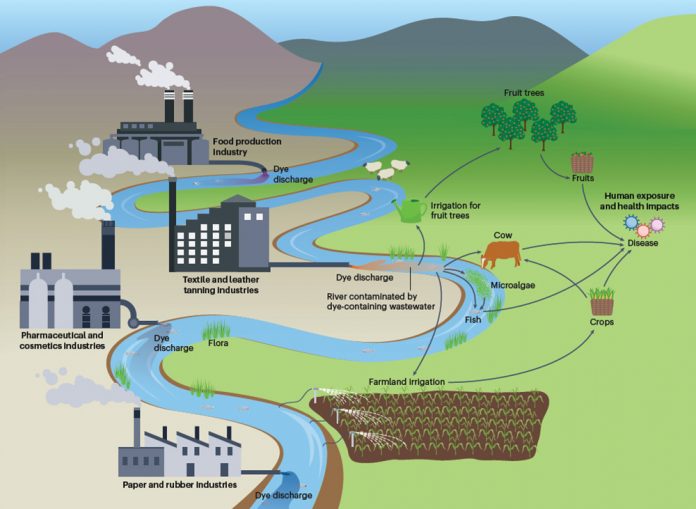The ecological and health threats of synthetic dyes in wastewater systems have led to calls for new laws on water management, and urgent investment in new sustainable treatment processes.
A new study reveals that billions of tons of dye-containing wastewater enter water systems every year, leading to a push for new sustainable technologies, including membrane-based nano-scale filtration. Researchers are also pushing for legislation to compel industrial producers to eliminate colourants before they reach public sewage systems or waterways.
The study, ‘Environmental impacts and remediation of dye-containing wastewater’, was written by academics from the University of Bath, the Chinese Academy of Sciences, the Fujian Agriculture and Forestry University, the Korea Institute of Energy Technology (KENTECH), and KU Leuven, Belgium.
Their research highlights that currently, up to 80% of dye-containing industrial wastewaters created in low- and middle-income countries are released untreated into waterways or used directly for irrigation. The authors say this poses a wide range of direct and indirect threats to human, animal and plant health.
Despite these ‘severe’ threats to health and ecosystems, the authors underscored that there is inadequate infrastructure, investment and regulatory effort for making dye usage more sustainable, or for treatment of dye-containing wastewater.
Dr Ming Xie, a lecturer in the Department of Chemical Engineering at the University of Bath (UK), believes that a multi-pronged approach is needed to combat the issue. He says: “Dyes create several problems when they reach water systems, from stopping light reaching the microorganisms that are the bedrock of our food chains, preventing their reproduction and growth, to more direct consequences like the toxic effects on plants, soils, animals and humans.
“There are several potential ways to remove dyes from water including chemical, biological and membrane-based techniques, but different dyes required different approaches, and once they reach wastewater systems treatment processes can be highly energy intensive.
“A worldwide regulatory effort is needed to stop dyes reaching wastewater or other water systems such as irrigation. Given the complexity of treating dye-containing wastewater, one solution would be to shift from the concept of centralised or regional treatment methods, to decentralised and site-specific treatment at source, by compelling industries to remove dyes from the wastewater they create before it reaches public water systems.”
Textile industry is biggest dye consumer
Mauveine, the first organic synthetic dye, was discovered in 1865, spurring the creation of the global dye industry. Since then, more than 10,000 different types of dyes have been synthesised, with annual global production today estimated at one million tons.
Dyes are used in the rubber, leather tanning, paper, food, pharmaceuticals and cosmetic industries, while the biggest user, the textile business, consumes 80% of produced synthetic dyes and generates about 70 billion tons of dye-containing wastewater annually.
China, India and Bangladesh combined discharge around 3.5 billion tons of textile wastewater each year. Water contamination is aggravated by synthetic dyes, which in light of water scarcity issues, makes dyes a fundamental environmental and sustainable development issue.
Untreated dyes cause colouration of water bodies, reducing the degree of visible light that passes through the surface layer – hindering photosynthesis for aquatic plants and creating impacts along the food chain.
Microalgae, which form the foundation of the aquatic food chain, are most sensitive to photosynthesis reduction, suffering growth inhibition and cell deformation when exposed to a synthetic dye. This effect, and the knock-on suppressed transfer of energy and nutrients up the food chain, could lead to breakdown of entire aquatic ecosystems.
The effects have also been observed in fish. Dyes can deposit in fishes’ gills, lateral lines or brains, leading to toxicological effects such as uncoordinated movement, respiratory distress, liver damage and kidney dysfunction. These effects not only reduce the nutritional value of the fish to predators, but also lower their reproductive rates. Toxic dyes can also bioaccumulate in the fishes’ fatty tissue, presenting health risks to humans and animals throughout the food chain.
Negative impacts of dyes are also found on land – where they disturb the balance of microbial communities in soil – and in humans. Exposure to dyes can trigger allergies, asthma and diseases including dermatitis and central nervous system disorders, as well as organ dysfunction and increased cancer risk.
No single solution
The review explores the variety of remediation technologies for dye-containing wastewater, including chemical, biological, physical and emerging advanced membrane-based techniques. The authors found that no single technique presents a ‘silver bullet’ for removing dyes, while several promising methods are not yet technologically ready at scale.
They suggest a collective effort, led by policymakers, to increase the adoption of advanced remediation technologies and change textile processing methods to minimise the use of the most toxic dyes.
The authors also highlight a potential commercial impetus – the scope for industries to create new revenue streams from the processing, separation and reuse of wastewater materials.
The research paper is available here.



